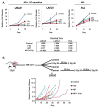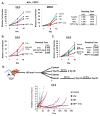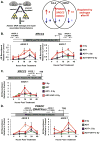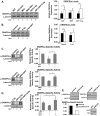A hormone-DNA repair circuit governs the response to genotoxic insult
- PMID: 24027197
- PMCID: PMC3823813
- DOI: 10.1158/2159-8290.CD-13-0108
A hormone-DNA repair circuit governs the response to genotoxic insult
Abstract
Alterations in DNA repair promote tumor development, but the impact on tumor progression is poorly understood. Here, discovery of a biochemical circuit linking hormone signaling to DNA repair and therapeutic resistance is reported. Findings show that androgen receptor (AR) activity is induced by DNA damage and promotes expression and activation of a gene expression program governing DNA repair. Subsequent investigation revealed that activated AR promotes resolution of double-strand breaks and resistance to DNA damage both in vitro and in vivo. Mechanistically, DNA-dependent protein kinase catalytic subunit (DNAPKcs) was identified as a key target of AR after damage, controlling AR-mediated DNA repair and cell survival after genotoxic insult. Finally, DNAPKcs was shown to potentiate AR function, consistent with a dual role in both DNA repair and transcriptional regulation. Combined, these studies identify the AR-DNAPKcs circuit as a major effector of DNA repair and therapeutic resistance and establish a new node for therapeutic intervention in advanced disease.
Significance: The present study identifies for the fi rst time a positive feedback circuit linking hormone action to the DNA damage response and shows the significant impact of this process on tumor progression and therapeutic response. These provocative findings provide the foundation for development of novel nodes of therapeutic intervention for advanced disease.
©2013 AACR.
Conflict of interest statement
Figures







Comment in
-
Prostate cancer: understanding why.Nat Rev Cancer. 2013 Nov;13(11):754. doi: 10.1038/nrc3615. Epub 2013 Oct 10. Nat Rev Cancer. 2013. PMID: 24108098 No abstract available.
-
Androgen receptor signaling fuels DNA repair and radioresistance in prostate cancer.Cancer Discov. 2013 Nov;3(11):1222-4. doi: 10.1158/2159-8290.CD-13-0679. Cancer Discov. 2013. PMID: 24203954
References
-
- Chapman JR, Taylor MR, Boulton SJ. Playing the end game: DNA double-strand break repair pathway choice. Mol Cell. 2012;47:497–510. - PubMed
-
- Gewirtz DA, Holt SE, Elmore LW. Accelerated senescence: an emerging role in tumor cell response to chemotherapy and radiation. Biochem Pharmacol. 2008;76:947–57. - PubMed
-
- Huang L, Snyder AR, Morgan WF. Radiation-induced genomic instability and its implications for radiation carcinogenesis. Oncogene. 2003;22:5848–54. - PubMed
-
- Bartkova J, Horejsi Z, Koed K, Kramer A, Tort F, Zieger K, et al. DNA damage response as a candidate anti-cancer barrier in early human tumorigenesis. Nature. 2005;434:864–70. - PubMed
Publication types
MeSH terms
Substances
Grants and funding
LinkOut - more resources
Full Text Sources
Other Literature Sources
Medical
Research Materials

